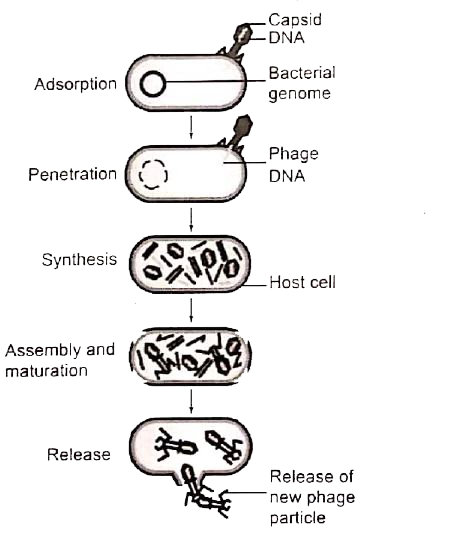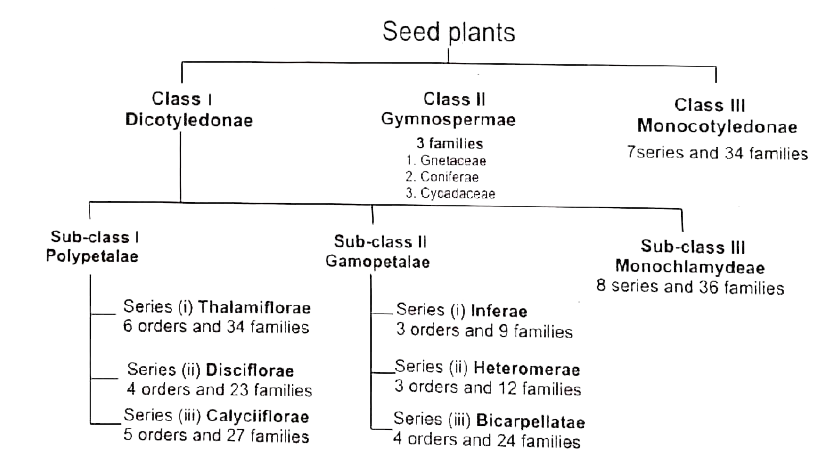Draw a flow chart depicting the Bentham and Hooker Classification.Solution in Tamil
Lytic cycle: During lytic cycle of phage ,disintegration of host bacterial cell occurs and the progeny virions are released.The steps involved in the lytic cycle are as follows:
(i) Adsorption : Phage (T4) particles interact with cell wall of host(E.coli).The phage tail makes contact between the two, and tail fibres recognize the specific receptor in phages.The on bacterial surface.The lipopolysaccharides of tail fibres act as receptor in phages.The process involving the recognition of phage to bacterium is called landing.Once the contact is and base plate to the cell surfaceThis step is called pinning.
(ii) Penetration: The penetration process involves mechanical and enzymatic dogestion of the cell wall of the host.At the recognition site phage digests certain wall structure by viral enzyme(lysozyme).After pinning the tail sheath contracts(using ATP) and appears shorterand thicker.After contraction of the base plate enlarges through which DNA is injected into the cell wall without using metabolic energy.The step involving injection of DNA particle alone intothe bacterial cell is called Transfection.The empty protein coat leaving outside the cell is known as 'ghost'.

(iii) Synthesis: This step involves the degradation of bacterial chromosome, protein synthesis and DNA replication. The phage nuclei acid takes over the host biosynthetic machinery. Host DNA gets inactivated and breaks down. Phage DNA suppresses the synthesis of bacterial protein and directs the metabolism of the cell to synthesis the proteins of the phage particlesand simultaneously replication of phage DNA also takes place.
Assembly and Maturation: The DNA of the phageand protein coat are synthesized separately and are assembled to form phage particles.The process of assembling the phage particles is known as maturation.After 20 minutes of infection about 300 new phages are assembled.
(v) Release : The phage particle gets accumulated inside the host cell and are released by the lysis of the host cell wall.[OR]

Topper's Solved these Questions
- BOOK - FULL MARKSCHAPTER - SAMPLE PAPER -7 (SOLVED)EXERCISE - Bio - Zoology (Part - I)8videos
SAMPLE PAPER -7 (SOLVED)
- BOOK - FULL MARKSCHAPTER - SAMPLE PAPER -7 (SOLVED)EXERCISE - Bio - Zoology (Part - II)7videos
SAMPLE PAPER -7 (SOLVED)
- BOOK - FULL MARKSCHAPTER - SAMPLE PAPER -7 (SOLVED)EXERCISE - Bio - Botany (Part - III)5videos
SAMPLE PAPER -7 (SOLVED)
- BOOK - FULL MARKSCHAPTER - SAMPLE PAPER -3 (SOLVED)EXERCISE - Bio -Zoology Part - IV4videos
SAMPLE PAPER -3 (SOLVED)
- BOOK - FULL MARKSCHAPTER - SAMPLE PAPER-09(UNSOLVED) EXERCISE - BIO ZOOLOGY (PART-IV)4videos
SAMPLE PAPER-09(UNSOLVED)
Similar Questions
Which is not a unit of taxonomic category?
01:58View SolutionWhy are spongin and spicules important to a sponge?
04:10View SolutionDo you think shape of chloroplast is unique for algae. Justify your answer.
03:06View SolutionWrite the general characters of the phylum echinodermata.
02:05View SolutionWrite bried notes on Dipoloblastic can Triploblastic with example.
02:31View SolutionClassification given by Bentham and Hooker is
04:13View SolutionBentham and Hooker proposed their system of classification in
02:59View SolutionClassification proposed by Bentham & Hooker is mainly based on
04:13View SolutionThe system of classification proposed by Bentham and Hooker is :-
03:08View SolutionExplain Bentham and Hooker system of classification?
02:26View SolutionDraw a flow chart depicting the Bentham and Hooker Classification.
02:26View SolutionDraw a flow chart depicting the classification of fruits.
50:47View SolutionDraw a flow chart depicting the Bentham and Hooker Classification.
00:53View SolutionDraw a Flow Chart depicting the Carbohydrate Classification.
01:47View Solutionबेंथम व हुकर के वर्गीकरण का प्रमुख गुण है -
01:27View Solution

